
Leptospermum petersonii, commonly known as lemon-scented teatree, is a species of shrub or small tree that is endemic to eastern Australia. It has thin, fibrous or flaky bark, often strongly-scented elliptic to lance-shaped leaves, white flowers and fruit that are retained for several years. It is commonly grown as an ornamental and is regarded as a minor environmental weed in some areas.

Sannantha is a genus of flowering plants in the family Myrtaceae that are native to Australia and New Caledonia. Plants in the genus Sannantha are shrubs or trees with leaves arranged in opposite pairs, flowers usually arranged in small groups, the peduncles often 1.5–2 times as long as the pedicels and with seven to fourteen stamens. The fruit is a thin-walled capsule containing flattened, D-shaped seeds. Some species of Sannantha were previously included in the genus Babingtonia.

Sannantha virgata is a flowering shrub species in the myrtle family, Myrtaceae. It is endemic to New Caledonia. Plants grow to between 0.5 and 3 metres high. White flowers appear in spring or summer with 5 rounded petals surrounding 7 to 10 stamens. The fruits are 1–2 mm wide and 2–3 mm in length.
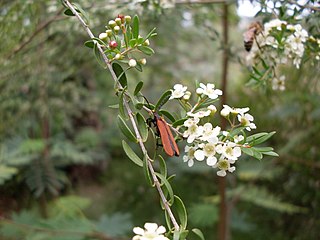
Sannantha pluriflora, commonly known as tall baeckea, is a species of flowering plant in the myrtle family, Myrtaceae, and is endemic to continental southeastern Australia. It is a shrub or small tree with lance-shaped to elliptic leaves, and groups of two to nine white flowers arranged in umbels in leaf axils.
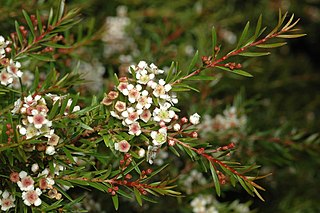
Sannantha bidwillii is a species in the myrtle family, Myrtaceae and is endemic to coastal Queensland in Australia. It is a shrub or tree with elliptic to egg-shaped leaves with the narrower end towards the base, and clusters of 3 white flowers.
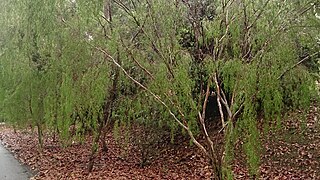
Leptospermum madidum is a species of shrub or small tree that is endemic to north-western Australia. It has weeping branches, smooth bark, pale green linear leaves, small white flowers and thin-walled fruit.
Homoranthus tricolor, is a flowering plant in the family Myrtaceae and is endemic to a small area in south-east Queensland. It is an upright shrub with linear to lance-shaped leaves and green, red and black flowers arranged singly or in pairs in upper leaf axils.
Leptospermum pallidum is a species of spreading shrub that is endemic to Queensland. It has thin, firm, rough bark, narrow lance-shaped leaves, white flowers arranged in groups of two or three on side shoots and fruit that remains on the plant until it dies.
Triplarina calophylla is a species of flowering plant in the myrtle family, Myrtaceae and is endemic to a restricted area of north Queensland. It is a shrub with egg-shaped leaves with the narrower end towards the base, flowers with five sepals, five white petals and fourteen or fifteen stamens.
Thryptomene remota is a species of flowering plant in the family Myrtaceae and is endemic to the northern part of the Northern Territory. It is an erect shrub with linear to lance-shaped leaves with the narrower end towards the base, and white or cream-coloured flowers with ten stamens.
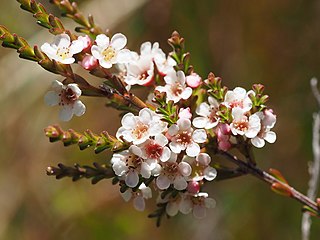
Baeckea omissa is a species of flowering plant in the family Myrtaceae and is endemic to eastern Australia. It is a shrub with egg-shaped to lance-shaped leaves with the narrower end towards the base and white flowers mostly with ten to fifteen stamens.
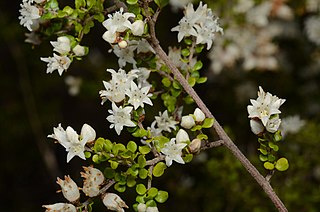
Cryptandra orbicularis is a species of flowering plant in the family Rhamnaceae and is endemic to south-eastern Queensland. It is a shrub with more or less round or kidney-shaped leaves and white to creamy-white, tube-shaped flowers.
Sannantha angusta is a species of flowering plant in the family Myrtaceae, and is endemic to eastern Australia. It has scaly to fibrous bark, narrowly lance-shaped to linear leaves and white flowers, and usually grows in forest on rocky hillsides. It was previously known as Babingtonia angusta, and has been cultivated as Baeckea sp. 'Clarence River'.
Sannantha brachypoda is a species in the myrtle family, Myrtaceae and is endemic to central Queensland in Australia. It is a shrub with egg-shaped leaves, the narrower end towards the base, and groups of 3 white flowers arranged in leaf axils.
Sannantha collina is a species in the myrtle family, Myrtaceae and is endemic to eastern in Australia. It is a shrub with lance-shaped leaves and groups of 3 to 7 white flowers arranged in leaf axils.
Sannantha crassa is a species in the myrtle family, Myrtaceae and is endemic to eastern Australia. It is a shrub with elliptic to lance-shaped leaves and groups of 7 to 9 white flowers arranged in leaf axils.

Sannantha crenulata, commonly known as fern-leaf baeckea, is a species of flowering plant in the myrtle family, Myrtaceae and is endemic to a restricted part of Victoria in Australia. It is an erect shrub with egg-shaped to round leaves with scalloped edges, and groups of usually 3 white flowers arranged in leaf axils.
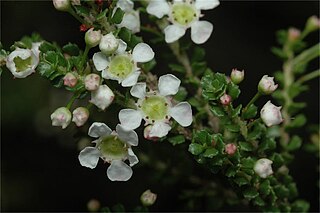
Sannantha cunninghamii is a species of flowering plant in the myrtle family, Myrtaceae and is endemic to eastern New South Wales. It is a shrub with round to broadly elliptic leaves with irregular edges, and white flowers arranged singly, in pairs or groups of three in leaf axils.
Sannantha papillosa is a species in the myrtle family, Myrtaceae and is endemic to north Queensland. It is a shrub with egg-shaped leaves, the narrower end towards the base, and groups of usually 7 white flowers arranged in leaf axils.
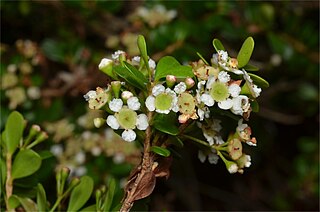
Sannantha tozerensis is a species of flowering plant in the myrtle family, Myrtaceae and is endemic to a small area of Cape York Peninsula in north Queensland. It is a shrub with elliptic to egg-shaped leaves, the narrower end towards the base, and white flowers arranged in groups of three or seven in leaf axils.











